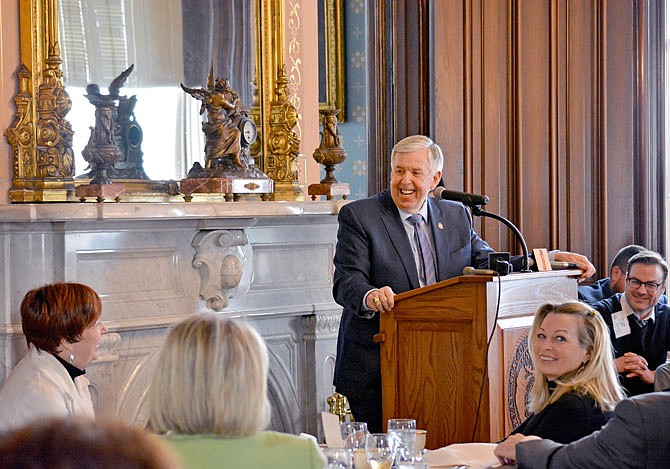After Missouri voters last November said "no" to a proposed 10-cent increase in the state's tax on motor fuels - phased-in over several years - Gov. Mike Parson said Thursday his bridge bonding proposal is an effort to get some needed improvements.
"It's not a thing where you can just sit around and say, 'We're not going to do nothing,'" Parson told reporters and newspaper editors gathered in the Governor's Mansion for the annual Missouri Press Association/Associated Press Day at the Capitol.
In his State of the State address two weeks ago, Parson asked lawmakers to approve issuing $350 million in general revenue bonds, to be repaid at $30 million a year for 15 years, so the state can repair or replace 250 bridges throughout Missouri that badly need the work.
Mid-Missouri could see 21 bridges repaired or replaced over the next three years, under Parson's plan.
The governor said the projects would be a long-term investment in improving Missouri infrastructure, because bridges "have a lifespan of 50-75 years."
Parson said Thursday when he and his staff first approached the state Transportation department with the idea, "We had never seen the map" showing which bridges MoDOT felt needed the most work.
But, he reminded the reporters and editors, MoDOT's annual STIP - Statewide Transportation Improvement Plan - includes projects around the state that have been recommended by local planning groups, "so we can't pick and choose what projects we want to put out there. That has to be done on the local level, so the local levels have input on what those projects are."
Parson's bonding plan also would fix bridges that are part of the state - or local - road systems, and are not eligible for federal matching funds.
But, Lt. Gov. Mike Kehoe told the reporters and editors earlier Thursday: "They're very important to communities and the safety of families."
If lawmakers approve the bonding idea, the bridges removed from the STIP and paid for with money from selling the bonds would leave room in the MoDOT plans for other projects that could qualify for a federal match - allowing the state's money to go farther.
"So, in that five-year period of time," Parson explained, "you throw all that together (and) it's about $1 billion worth of construction over the state of Missouri" - and not just the $350 million that the bonding plan would free-up for other projects.
Some state senators - especially from the St. Louis and Kansas City areas - have complained the proposal doesn't include enough bridges in those regions.
"This project list doesn't come down from Mount Sinai on stone tablets," Sen. Bob Onder, R-Lake St. Louis, told the Associated Press after Parson met privately with Senate Republicans this week, about the bond proposal. "I'd like to be able to support it, but in its present form it needs work."
Transportation Director Patrick McKenna told reporters two weeks ago that most of the bridges are in rural areas.
The governor's plan involves bridges that can be repaired or replaced for less than $8 million each. And that, McKenna said, means the bond money tends to go toward projects in rural areas, where bridges often are smaller and less expensive to work on.
Sen. Jason Holsman, D-Kansas City, told the AP that residents from the metropolitan regions understand that revenue from those areas is used to help rural Missouri, "but that doesn't mean that we're also not going to fight for what we believe is our equitable portion of those resources."
However, Parson told the reporters and editors Thursday, the metropolitan areas will benefit more from the state's formula used to distribute the money for the projects that would be added to the STIP, after the bonding money removed the bridges from it.
"In the $350 million to be added, the St. Louis region gets about $120 million," Parson said. "The Kansas City region would get about $80 million of that.
"So, close to $200 million of the $350 million goes to those two areas, and the rest of it would be throughout the rest of the state."
Parson - who became governor just eight months ago, when then-Gov. Eric Greitens resigned in the face of criminal charges filed in St. Louis and a possible impeachment by the Missouri House - has made infrastructure improvements a main goal of his administration.
Both he and Kehoe acknowledged the bonding plan isn't the whole solution to Missouri's infrastructure needs.
"Although those (bridge) fixes do not fix our statewide transportation problem, they do at least keep the safety of some of those structures moving," Kehoe said.
The governor said: "In my mind, the problem still exists, and we have to find a (long-term) solution."

